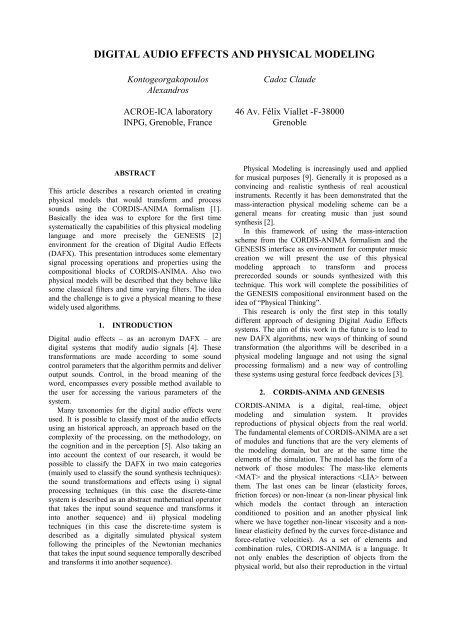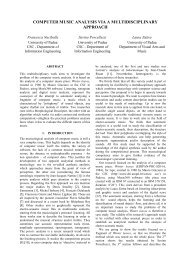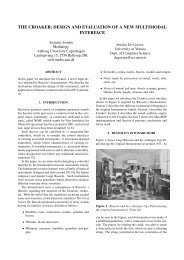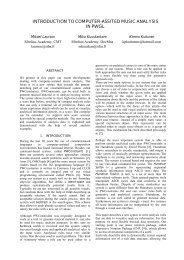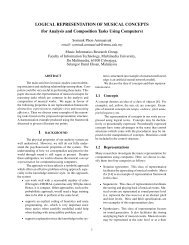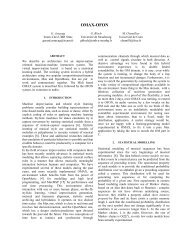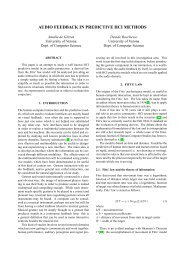digital audio effects and physical modeling - Sound and Music ...
digital audio effects and physical modeling - Sound and Music ...
digital audio effects and physical modeling - Sound and Music ...
You also want an ePaper? Increase the reach of your titles
YUMPU automatically turns print PDFs into web optimized ePapers that Google loves.
DIGITAL AUDIO EFFECTS AND PHYSICAL MODELING<br />
Kontogeorgakopoulos<br />
Alex<strong>and</strong>ros<br />
ACROE-ICA laboratory<br />
INPG, Grenoble, France<br />
Cadoz Claude<br />
46 Av. Félix Viallet -F-38000<br />
Grenoble<br />
ABSTRACT<br />
This article describes a research oriented in creating<br />
<strong>physical</strong> models that would transform <strong>and</strong> process<br />
sounds using the CORDIS-ANIMA formalism [1].<br />
Basically the idea was to explore for the first time<br />
systematically the capabilities of this <strong>physical</strong> <strong>modeling</strong><br />
language <strong>and</strong> more precisely the GENESIS [2]<br />
environment for the creation of Digital Audio Effects<br />
(DAFX). This presentation introduces some elementary<br />
signal processing operations <strong>and</strong> properties using the<br />
compositional blocks of CORDIS-ANIMA. Also two<br />
<strong>physical</strong> models will be described that they behave like<br />
some classical filters <strong>and</strong> time varying filters. The idea<br />
<strong>and</strong> the challenge is to give a <strong>physical</strong> meaning to these<br />
widely used algorithms.<br />
1. INTRODUCTION<br />
Digital <strong>audio</strong> <strong>effects</strong> – as an acronym DAFX – are<br />
<strong>digital</strong> systems that modify <strong>audio</strong> signals [4]. These<br />
transformations are made according to some sound<br />
control parameters that the algorithm permits <strong>and</strong> deliver<br />
output sounds. Control, in the broad meaning of the<br />
word, encompasses every possible method available to<br />
the user for accessing the various parameters of the<br />
system.<br />
Many taxonomies for the <strong>digital</strong> <strong>audio</strong> <strong>effects</strong> were<br />
used. It is possible to classify most of the <strong>audio</strong> <strong>effects</strong><br />
using an historical approach, an approach based on the<br />
complexity of the processing, on the methodology, on<br />
the cognition <strong>and</strong> in the perception [5]. Also taking an<br />
into account the context of our research, it would be<br />
possible to classify the DAFX in two main categories<br />
(mainly used to classify the sound synthesis techniques):<br />
the sound transformations <strong>and</strong> <strong>effects</strong> using i) signal<br />
processing techniques (in this case the discrete-time<br />
system is described as an abstract mathematical operator<br />
that takes the input sound sequence <strong>and</strong> transforms it<br />
into another sequence) <strong>and</strong> ii) <strong>physical</strong> <strong>modeling</strong><br />
techniques (in this case the discrete-time system is<br />
described as a <strong>digital</strong>ly simulated <strong>physical</strong> system<br />
following the principles of the Newtonian mechanics<br />
that takes the input sound sequence temporally described<br />
<strong>and</strong> transforms it into another sequence).<br />
Physical Modeling is increasingly used <strong>and</strong> applied<br />
for musical purposes [9]. Generally it is proposed as a<br />
convincing <strong>and</strong> realistic synthesis of real acoustical<br />
instruments. Recently it has been demonstrated that the<br />
mass-interaction <strong>physical</strong> <strong>modeling</strong> scheme can be a<br />
general means for creating music than just sound<br />
synthesis [2].<br />
In this framework of using the mass-interaction<br />
scheme from the CORDIS-ANIMA formalism <strong>and</strong> the<br />
GENESIS interface as environment for computer music<br />
creation we will present the use of this <strong>physical</strong><br />
<strong>modeling</strong> approach to transform <strong>and</strong> process<br />
prerecorded sounds or sounds synthesized with this<br />
technique. This work will complete the possibilities of<br />
the GENESIS compositional environment based on the<br />
idea of “Physical Thinking”.<br />
This research is only the first step in this totally<br />
different approach of designing Digital Audio Effects<br />
systems. The aim of this work in the future is to lead to<br />
new DAFX algorithms, new ways of thinking of sound<br />
transformation (the algorithms will be described in a<br />
<strong>physical</strong> <strong>modeling</strong> language <strong>and</strong> not using the signal<br />
processing formalism) <strong>and</strong> a new way of controlling<br />
these systems using gestural force feedback devices [3].<br />
2. CORDIS-ANIMA AND GENESIS<br />
CORDIS-ANIMA is a <strong>digital</strong>, real-time, object<br />
<strong>modeling</strong> <strong>and</strong> simulation system. It provides<br />
reproductions of <strong>physical</strong> objects from the real world.<br />
The fundamental elements of CORDIS-ANIMA are a set<br />
of modules <strong>and</strong> functions that are the very elements of<br />
the <strong>modeling</strong> domain, but are at the same time the<br />
elements of the simulation. The model has the form of a<br />
network of those modules: The mass-like elements<br />
<strong>and</strong> the <strong>physical</strong> interactions between<br />
them. The last ones can be linear (elasticity forces,<br />
friction forces) or non-linear (a non-linear <strong>physical</strong> link<br />
which models the contact through an interaction<br />
conditioned to position <strong>and</strong> an another <strong>physical</strong> link<br />
where we have together non-linear viscosity <strong>and</strong> a nonlinear<br />
elasticity defined by the curves force-distance <strong>and</strong><br />
force-relative velocities). As a set of elements <strong>and</strong><br />
combination rules, CORDIS-ANIMA is a language. It<br />
not only enables the description of objects from the<br />
<strong>physical</strong> world, but also their reproduction in the virtual
space of simulation. This language, which allows high<br />
modularity will be used for the conception <strong>and</strong> the<br />
construction of our models that will serve as <strong>digital</strong><br />
<strong>audio</strong> <strong>effects</strong> units.<br />
The GENESIS environment is based on the<br />
topological CORDIS-ANIMA mass interaction system<br />
[6]. It is a user interface, dedicated to musical creation,<br />
that allows the user to design his <strong>physical</strong> models with<br />
the CORDIS-ANIMA language thanks to various model<br />
editing functions <strong>and</strong> various tools to define the<br />
parameters, observe the movement of the models, hear<br />
the sound that they produce, etc…The basic modules for<br />
GENESIS are the MAS for the inertia (one-dimensional<br />
movement, parameters: M the mass <strong>and</strong> the initial<br />
conditions X0 for the position <strong>and</strong> Vo for the velocity),<br />
the SOL for the fixed point (parameters: the initial<br />
condition X0 for the position), the REF for the viscoelastic<br />
interaction MAS-MAS or MAS-SOL (the<br />
interaction force is calculated in function of parameters:<br />
Z for the damping <strong>and</strong> K for the stiffness) which is<br />
combination of two more elementary elements RES for<br />
the elasticity <strong>and</strong> FRO for the viscosity, the CEL for the<br />
combination SOL-MAS-REF (it’s actually an elementary<br />
oscillator), the BUT which is a REF conditioned to the<br />
position (parameters: all the REF parameters <strong>and</strong> the<br />
threshold S0 where for values below S0 the REF<br />
interaction is activated), the LNL where we have together<br />
a non linear viscosity <strong>and</strong> a non linear elasticity defined<br />
by the curves force-distance <strong>and</strong> force-relative velocities<br />
(parameters: the discrete points <strong>and</strong> the interpolation<br />
formula that defines the curves).<br />
3. DIGITAL AUDIO EFFECTS BASED ON<br />
PHYSICAL MODELS<br />
3.1. Simple Signal processing<br />
We will present how we can realize some elementary<br />
signal processing operations using the compositional<br />
blocks of CORDIS-ANIMA. Of course our aim is not to<br />
treat the signals using mathematical operators<br />
implemented with these mechanical structures, we just<br />
want to present a wide plan of the possibilities or the<br />
toolbox we have when we are using <strong>physical</strong> <strong>modeling</strong><br />
for the purpose of signal processing.<br />
3.1.1. Feed forward interconnection link<br />
We have two ways to connect two mechanical systems. It<br />
is possible to consider as the output of the first system<br />
<strong>and</strong> as the input of the second system either the force or<br />
the position, even though the variables in the Newtonian<br />
mechanics are duals <strong>and</strong> it’s impossible to separate them.<br />
With the computer simulation <strong>and</strong> real time control we<br />
are forced into doing that. In general all <strong>physical</strong><br />
communications (which are intrinsically non-oriented)<br />
are presented by two-way communication carried out by<br />
divisible input/output pairs (this is a constraint inherited<br />
by the information theory <strong>and</strong> the capabilities of the<br />
technology). So when we want to design a feed forward<br />
interconnection link (this is the case when we<br />
interconnect <strong>digital</strong> <strong>audio</strong> <strong>effects</strong> although with the forcefeedback<br />
connection –something possible with CORDIS-<br />
ANIMA we may have interesting results) we have four<br />
possibilities (we will present them using the CORDIS-<br />
ANIMA formalism <strong>and</strong> the GENESIS symbolism).<br />
Something very important that we must not forget is that<br />
Genesis is always normalizing the output. So if we have a<br />
very weak signal it is still possible for it to be heard with<br />
the maximum amplitude; however if it is combined with<br />
other signals it may not be heard at all. So important is<br />
not the absolute amplitude of the output of one<br />
subsystem but the relative amplitude considering the<br />
other subsystems that are participating in the generation<br />
of the final sound.<br />
• Position as Output/Force as Input<br />
This is the more usual case. We are searching the<br />
following relation (figure 1): F1 ∝ x1<br />
If we use as LIA F (from the CORDIS_ANIMA<br />
k<br />
algorithms we get the equation<br />
j−><br />
i<br />
F ( n)<br />
= −k<br />
[ x ( n)<br />
− x ( n)]<br />
= −k<br />
∆x<br />
) we can see that for<br />
k<br />
ij<br />
ij<br />
i<br />
−10<br />
10 |<br />
2−INITIAL<br />
| |<br />
1<br />
|<br />
j<br />
k ≈ X
use it’s output (so we assume that this mass is stable for<br />
that system) <strong>and</strong> we also ensure that the initial positions<br />
of the system 2 (passive system) are negligible<br />
comparing x produced by the algorithm of the mass so<br />
that F ≪ F , we get the conditions that we need. The<br />
2 1<br />
input/output relation is 1<br />
x = F<br />
2 1<br />
mF<br />
CEL<br />
s<br />
System1<br />
OUT<br />
x 1<br />
System1<br />
RES-CEL<br />
LIA<br />
x 2<br />
-F 1<br />
CEL<br />
System2<br />
F 2<br />
System2<br />
System1<br />
System2<br />
F 1<br />
-F 1<br />
x 2<br />
IN<br />
OUT<br />
System1<br />
F 1<br />
CEL<br />
F 2<br />
System2<br />
Figure 4. Interconnection of systems - Position as<br />
Output/Position as Input case using the GENESIS <strong>and</strong> the<br />
CORDIS-ANIMA symbolism<br />
3.1.2. Addition<br />
Figure 2. Interconnection of systems - Force as<br />
Output/Position as Input case using the GENESIS <strong>and</strong> the<br />
CORDIS-ANIMA symbolism<br />
• Force as Output/Force as Input<br />
x<br />
IN<br />
k z<br />
Using a CEL with m = = , we get a constant<br />
2<br />
F F<br />
s s<br />
frequency response. So applying many forces to a CEL<br />
like that we get an adder. The input/output relation is:<br />
1<br />
x = F . We observe that there is also an<br />
2 ∑<br />
mFs<br />
amplitude modification.<br />
This case is a combination of the two previous examples.<br />
We are searching the following relation (figure<br />
3): F2 ∝ F . Using exactly the same conditions as before<br />
1<br />
we get an Input/Output relation k<br />
F2 = F<br />
2 1<br />
mF<br />
s<br />
System1<br />
System2<br />
IN<br />
IN<br />
CEL<br />
OUT<br />
System1<br />
F 1<br />
OUT<br />
System1<br />
CEL<br />
x 1<br />
F 2<br />
Figure 3. Interconnection of systems - Force as Output/Force<br />
as Input case using the GENESIS <strong>and</strong> the CORDIS-ANIMA<br />
symbolism<br />
• Position as Output/Position as Input<br />
x 1<br />
F 2<br />
CEL -RES<br />
LIA<br />
System2<br />
System2<br />
This case is again a combination of the two previous<br />
examples. We are searching the following relation<br />
(figure 4): x2 ∝ x . Using exactly the same conditions as<br />
1<br />
before we get an Input/Output relation k<br />
x2 = x .<br />
2 1<br />
mF<br />
x 2<br />
-F 2<br />
IN<br />
s<br />
Figure 5. Addition of system output signals using the<br />
GENESIS symbolism<br />
3.1.3. Subtraction<br />
Using one RES with a very small negative elasticity<br />
coefficient <strong>and</strong> one RES with a very small positive<br />
elasticity coefficient <strong>and</strong> a CEL with the parameters<br />
m = k = z we get the signal directly inverted. We have<br />
seen a similar network before (Position as<br />
Output/Position as Input - interconnection). This is clear<br />
from the input/output relation k<br />
x = ( x ).<br />
2 1<br />
− x As we<br />
2<br />
mFs<br />
had mentioned before, if x 1 = x <strong>and</strong> these are not external<br />
2<br />
signals, the resulted sound is not zero but a signal heard<br />
as a beat. This can easily be explained if we reach the<br />
assumptions we made about the feed forward<br />
interconnection of the system that produce the signal <strong>and</strong><br />
the system that modify the signal; the very small<br />
feedback we get is efficient to give a result like that (after<br />
the normalization). For example if take as input two<br />
CELS with same characteristics <strong>and</strong> we subtract them we<br />
will take a beat as the output. The reason is that the final<br />
coefficients of elasticity (CEL <strong>and</strong> RES) are not exactly<br />
the same. This theoretically negligible difference gives
an important <strong>audio</strong> result after the normalization (the<br />
signal before the normalization may be of order<br />
20<br />
10 − ).<br />
This equation describes a b<strong>and</strong> pass filter realized by<br />
second order all-pole filter:<br />
System1<br />
IN<br />
RES1<br />
OUT<br />
CEL<br />
y( n) = b x( n) − a y( n −1) − a y( n − 2)<br />
(2)<br />
0 1 2<br />
System2<br />
IN<br />
RES2<br />
This filer is the most frequently found in computer music<br />
software [8].<br />
Figure 6. Subtraction of system output signals using the<br />
GENESIS symbolism<br />
3.1.4. Amplification<br />
The RES is working as an amplification system since the<br />
Input/Output equation is F k = −kx<br />
(the output is the<br />
force). Using it properly we are able to define accurately<br />
the amplitude in our system. It can be used with the<br />
adder as a mixing tool. Again we can use instead of<br />
RES a FRO which is safer considering the perturbation<br />
which is coming with the undesired filtering <strong>effects</strong>.<br />
Input<br />
System<br />
Figure 7. Amplification of system output signals using the<br />
GENESIS symbolism<br />
3.2. Constant time filters<br />
Now we will present some basic structures, which will<br />
behave as filters. It’s well known that all linear systems<br />
are acting as filters. Especially every linear CORDIS-<br />
ANIMA network where all the elements are<br />
terminated by a element resulting in a<br />
frequency responsive linear combination of second order<br />
IIR filters. Every input/output pair in this network gives<br />
different liner combinations; but with the same modesresonators.<br />
The initial conditions can also change the<br />
coefficient of the linear combination. The modes are<br />
affected only by the elasticity factors k when we have<br />
input force. The damping factors z are affecting the<br />
oscillation time.<br />
3.2.1. B<strong>and</strong> pass filter<br />
If we use the algorithms of CORDIS-ANIMA [7] we can<br />
find that the CEL has an input/output function (for<br />
GENESIS we give F s =1):<br />
k12<br />
z12<br />
y(<br />
n)<br />
+ [ −2<br />
+ + ] y(<br />
n −1)<br />
+<br />
2<br />
mFs mFs<br />
(1)<br />
z12<br />
1<br />
[1 − ] y(<br />
n − 2) = x(<br />
n −1)<br />
2<br />
mF<br />
mF<br />
s<br />
IN<br />
OUT<br />
RES<br />
s<br />
SOL<br />
Input System<br />
Figure 8. B<strong>and</strong> pass filter using the GENESIS symbolism<br />
Using the formula to compute the coefficients for a<br />
desired resonant frequency <strong>and</strong> b<strong>and</strong>width we get the<br />
expression:<br />
k = mF ( a + a + 1) z = mF (1 − a )<br />
2<br />
s<br />
1 2 s 2<br />
a = − 2e cos(2 π F / 44100) a = e<br />
−π<br />
B / 44100 −2 π B / 44100<br />
1 2<br />
3.2.2. High pass filter<br />
(3)<br />
The FRO is behaving as a high pass filter. From the<br />
CORDIS-ANIMA algorithms we have for the FRO<br />
element:<br />
y( n)<br />
= −z12 Fs x(<br />
n)<br />
+ z12<br />
Fs<br />
x(<br />
n −1)<br />
(4)<br />
It is a high pass FIR filter. Its amplitude response in the<br />
frequency domain is<br />
F<br />
H ( F) = z12<br />
Fs<br />
sin( π )<br />
(5)<br />
f<br />
The cutoff frequency is f s /4 .<br />
Input System<br />
s<br />
FRO<br />
IN OUT<br />
SOL<br />
Figure 9. Low pass filter using the GENESIS symbolism<br />
IN<br />
OUT
3.2.3. Complex filters<br />
Using combinations of the above models we can get<br />
more complicated filters. For example we can get filter<br />
banks by using many CELs with different <strong>physical</strong><br />
characteristics, processing the same signal in parallel <strong>and</strong><br />
adding the outputs with the model we saw before.<br />
Systems like that can be used to easily model the<br />
behavior of complicated linear systems like the resonant<br />
boxes of musical instruments .We can also use those<br />
models in cascading form. We must not forget the feed<br />
forward connection. In this case we have to take into<br />
account the limitations of the processing machine; we are<br />
not free to calculate signals of any order (for example an<br />
extremely case 10 -50 ) <strong>and</strong> with the decoupling techniques<br />
described above it’s not difficult to touch those limits.<br />
3.3. Time varying filters<br />
The goal is to design filters where some characteristics<br />
like the gain, the resonant frequency or the b<strong>and</strong>width are<br />
time-variant. The control of these parameters can be<br />
achieved using external force feedback controllers or<br />
special <strong>physical</strong> models that are controlling the dynamic<br />
behavior of the models used as variable filters. The<br />
method we will use is based on changing the <strong>physical</strong><br />
parameters of the filters like the elasticity factor K, the<br />
damping factor Z <strong>and</strong> the mass M.<br />
A b<strong>and</strong> pass filter with time depended resonance<br />
frequency <strong>and</strong> b<strong>and</strong>width can be designed using a CEL<br />
module. The CEL is behaving as second order IIR<br />
resonant filter. If we change the <strong>physical</strong> parameters K, Z<br />
<strong>and</strong> M we affect the frequency response of the filter. One<br />
way to do that <strong>physical</strong>ly is to use not linear elasticity<br />
force. We must note that in nature we have<br />
approximately linear elasticity forces.<br />
F<br />
Figure 10. Stretching a real spring<br />
Even from our everyday experience we underst<strong>and</strong><br />
that when we have the following system (figure 10 - K is<br />
depending on the elongation of the spring - usually the<br />
real world is like that) <strong>and</strong> we apply opposite forces on<br />
the side of the spring, the mass will vibrate with<br />
different frequencies. The forces are controlling the<br />
elasticity coefficient of the structure.<br />
We can design our effect using the same principle.<br />
We will use with no linear characteristics (figure<br />
11 – the LNK1 And LNK2 are he non-linear RES) <strong>and</strong><br />
we will apply forces or positions on the side of the<br />
system.<br />
-F<br />
Input System<br />
RES1 M1 LNLK1<br />
M2<br />
LNLK2<br />
FRO1 IN<br />
FRO2<br />
SOL<br />
M<br />
OUT<br />
RES2<br />
Figure 11. Time variable filter using the GENESIS<br />
symbolism<br />
This mathematically is translated as a change in the<br />
function point of the non-linear characteristic of K<br />
(figure 12).<br />
Figure 12. Non-linear characteristic of K<br />
SOL<br />
The gradient in every point of the characteristic is<br />
defining the elasticity coefficient. The curve has to be<br />
continuous because the transition from one region of the<br />
curve to another can’t be instaneous (the noncontinuities<br />
give non desirable <strong>and</strong> nearly unpredictable<br />
results).<br />
4. CONCLUSION AND FUTURE WORKS<br />
The most interesting point of this approach is that it<br />
allows you to create <strong>and</strong> imagine the system by “<strong>physical</strong><br />
thinking”; it’s possible to transfer your experience from<br />
the <strong>physical</strong> world <strong>and</strong> using the intuitive environment of<br />
GENESIS to build <strong>and</strong> implement the desired system.<br />
You can base your research <strong>and</strong> strategy in mechanical<br />
physics <strong>and</strong> not in mathematical operations with signals.<br />
Of course they are many constraints in this approach<br />
basically concerning the interaction of <strong>physical</strong> systems<br />
<strong>and</strong> the energetic scale at which the phenomena are<br />
taking place. The idea to explore systematically for the<br />
first time the capabilities of a general <strong>physical</strong> <strong>modeling</strong><br />
environment as GENESIS for the creation of Digital<br />
Audio Effects (DAFX) was a challenge. This approach<br />
ended up very interesting <strong>and</strong> hopeful.<br />
The ambition to create <strong>and</strong> imagine the processing<br />
system by “<strong>physical</strong> thinking” can be a reality with a<br />
<strong>modeling</strong> language like CORDIS-ANIMA <strong>and</strong> the<br />
helpful interface of GENESIS. We certified that it’s<br />
possible to transfer your experience from the <strong>physical</strong>
world to build <strong>and</strong> implement the desired system with<br />
this environment.<br />
This research was only the first small step in this<br />
totally different approach of designing Digital Audio<br />
Effect systems. The aim of this work is to lead in new<br />
DAFX algorithms, new ways of thinking about sound<br />
transformation <strong>and</strong> probably a new way of controlling<br />
these systems using gestural force feedback devices.<br />
Many steps have to be yet taken in underst<strong>and</strong>ing <strong>and</strong><br />
transferring the knowledge <strong>and</strong> experience from the<br />
domain of Digital Audio Effects using signal-processing<br />
techniques to the <strong>physical</strong> <strong>modeling</strong> area. We believe<br />
that by building a stable <strong>and</strong> complete research<br />
framework we will open a whole new chapter in how we<br />
process sounds to create music.<br />
5. REFERENCES<br />
[1] Cadoz C., Luciani A. <strong>and</strong> Florens J. L.<br />
''CORDIS-ANIMA: A modelling <strong>and</strong><br />
Simulation System for <strong>Sound</strong> <strong>and</strong> Image<br />
Synthesis – The General Formalism'', Computer<br />
<strong>Music</strong> Journal 17(4) 1993.<br />
[2] Castagne N., Cadoz C. ''Creating music by<br />
means of ‘Physical Thinking’: The <strong>Music</strong>ian<br />
oriented GENESIS environment'', Proceedings<br />
of the 5ith International Conference n Digital<br />
Audio Effects (DAFX-02), Hamburg, Germany,<br />
2002<br />
[3] Cadoz C., Lisowski L. <strong>and</strong> Florens J. L. ''A<br />
modular Feedback Keyboard design'',<br />
Computer <strong>Music</strong> Journal 14(2) 1990.<br />
[4] Udo Zolzer, Digital Audio Effects, John Wiley<br />
& Sons Ltd 2002<br />
[5] Verfaille V., ''Effets <strong>audio</strong>numériques adaptifs :<br />
théorie, mise en œuvre et usage en création<br />
musicale numérique'', PhD University of Aix-<br />
Marsaille II, France, 2003<br />
[6] Incerti E., ''Synthèse de sons par modélisation<br />
physique de structures vibrantes : application<br />
pour la création musicale par ordinateur'', PhD<br />
Institut National Polytechnique de Grenoble,<br />
France, 1993<br />
[7] Cadoz C., Luciani A. <strong>and</strong> Florens J. L., ''The<br />
<strong>physical</strong> Model, Modelisation <strong>and</strong> Simulation<br />
Systems for the Instrumental'', In<br />
Representation of <strong>Music</strong>al Signals, G. De Poli,<br />
A. Picciali, C. Roads, Ed. MIT Press, 1991<br />
[8] Dodge C., Jerse T.: Computer <strong>Music</strong>:<br />
synthesis, composition <strong>and</strong> performance,<br />
second edition, Schirmer Books New York,<br />
1997<br />
[9] Borin G, De Poli G. <strong>and</strong> Sarti A. : ''Algorithms<br />
<strong>and</strong> Structures for Synthesis Using Physical<br />
Models'', Computer <strong>Music</strong> Journal 16(4), 1992


